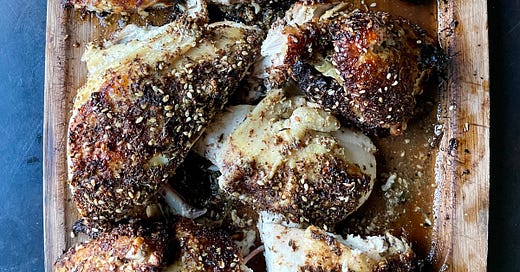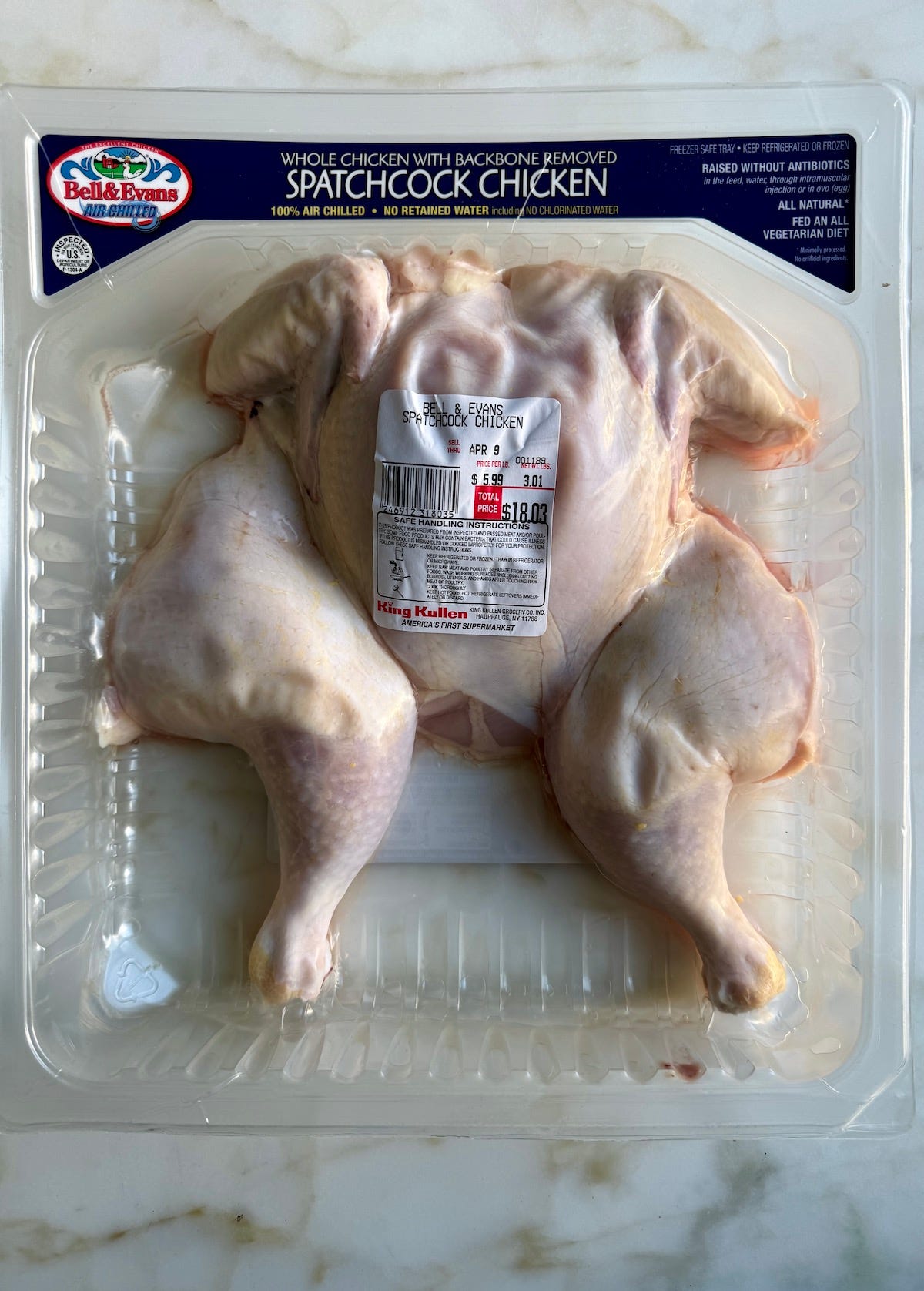I want to thank everyone who commented so passionately on last week’s newsletter, not only with why you wanted to win the Rancho Meladuco giveaway, but also with all your deeply personal stories and nostalgic memories about eating dates. They really moved me and, as always, I loved learning more about all of you. Congratulations to Constance McAninch, who was the lucky winner!
Now, can we talk about the magical powers yogurt has when it comes to marinating chicken — and other meats too, btw? Similar to the effect of buttermilk, and for the same reasons, a yogurt marinade is the path to juicy, tender, and flavorful chicken. Both the active cultures and the lactic acid in yogurt transform the meat. And before you ask, if you don’t do dairy, it looks like coconut yogurt contains live cultures, so it would probably be a decent substitute. I haven’t tried it though, so let me know if you do!
This is a case in which I am going to ask you to think ahead by a day, because it really does take 24 hours (though 12 will suffice in a pinch) for the marinade to work its magic. For this particular recipe, after a long soak in the marinade, the chicken gets coated in a thick crust of spices that transforms the skin into a crispy, flavorful layer that seals in all those juices, whether you choose to grill or roast your bird.
I used a spatchcocked chicken for today’s recipe, partly because I’ve noticed them already butchered and packaged this way lately, which is a major convenience. If your local supermarket carries Bell & Evans, have you seen this new product?
I don't find it difficult to do the work myself, but it is a bit messier, and not everyone has the confidence to cut out the backbone (best done with poultry shears) then crack the breastbone so that the chicken lies flat. That’s all it takes, but still, this is easier! You can also ask your butcher to do it for you.
You may be wondering how spatchcocking — a word that has become so ubiquitous in recent years — differs from butterflying. In terms of poultry, it’s exactly the same thing, so don’t be confused by the terms. Spatchcock is more fun to say though, isn’t it?
The advantages of spatchcocking a chicken are:
It’s easier to season and marinate what was the inside of the bird
It cooks in less time
It cooks more evenly
Both sides of the chicken can achieve crispiness
The final presentation isn't really the point here, because it can look a bit odd all splayed out, and I admit that I have on more than one occasion spatchcocked a chicken myself only to find the legs are attached just by the skin, making the whole chicken a bit floppy. In those cases, I just cut right through the breastbone so I have two half chickens, which can be a bit easier to manage, especially on the grill.

The za’atar spice mixture you’ll be coating the chicken with after it emerges from its overnight bath can be homemade or store bought. I like to make my own mix for this recipe, because, for one thing, it uses quite a lot (trust me on that), which might deplete your little jar of za’atar. The other reason is that the mix of spices in a za’atar blend can vary a lot due to both regional variations and by manufacturer, so you have more control over the flavor this way.

That said, if you have a za’atar blend you like — and you don’t mind depleting your stash! — go ahead and use it, just be mindful of how much salt you add to the coating. Most za’atar blends already have salt in them, and sumac, which I highly recommend adding if you can get it, sometimes has salt added to it as well (though not always). If the label says ”cured sumac,” it has salt. You can see it, and you can certainly taste it, or just check the label. Either way, once you’ve mixed all the spices, I suggest tasting a bit to gauge how much, if any, additional salt you need to add. It should taste a little salty!
You can add the spices however you see fit. I like to pat mine on, but you could add a healthy dose of za’atar — or any of the spices listed in the recipe — right into the marinade if you’d like; just freestyle it and sprinkle them in. This is also a good time to tell you that if you want to skip the step of adding spices altogether, the yogurt-marinated chicken is still delicious in its own right. That said, know that the spice rub helps prevent the chicken from sticking to the grill, so if your spices are incorporated into the marinade (or if you’re just using the yogurt marinade by itself), you will want to make sure the grill/grill platter is really well oiled and use a spatula to help loosen the chicken from the grill.
I like to use my trusty grill platter to cook things like this. You can thoroughly oil it just before the food goes on, and if for any reason the chicken sticks to it on the second side (the skin side), you can just slide the whole platter onto a sheet pan and bring it inside, where it will slowly release itself as it rests. A big folded sheet of heavy-duty foil can stand in here and will give you that same flexibility, if you don’t have a grill platter.
If you decide to roast the chicken instead, just throw it on a foil-lined sheet pan and cook it for about the same time at the same temperature. Turn up to convection at the end if you need more color on the outside (you could also broil it, but would need to keep a close eye on it to ensure the spices don’t burn). And keep in mind that with any of these options, you will still want to use your instincts when making that crucial judgment about when the chicken is done since there are so many variables, including the size of the chicken, the exact heat of your grill or oven, how cold your chicken is at the start, etc. I highly recommend using an instant-read thermometer to check for doneness in the thickest part of the breast. It should be just a hair under 165℉, because the temperature will continue to rise; 45 minutes is a good starting point, but it could take longer.
I know that with all this explaining, I run the risk of intimidating you, but really this recipe is quite easy and you can choose your own adventure here. Use your instincts and you’ll be rewarded with a very delicious dinner (and leftovers too!).
And now for the recipe!
Za’atar Yogurt Chicken
Serves 2 to 4
For the chicken and marinade:






